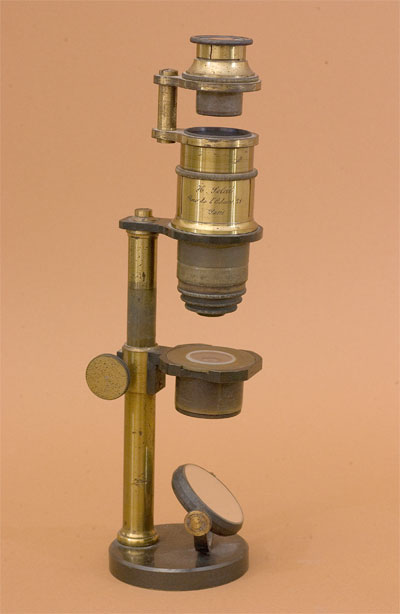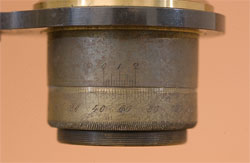 |
|||||
 |
 |
||||
 |
|||||
 |
 |
||||
Compound Polarized Light Microscope (No. 74 ) |
|||||||||||
 |
|||||||||||
| Age: c1850 Made by: Henri Soleil Made in: France |
|||||||||||
 |
|||||||||||
|
H. Soleil, Rue de L'odeon 21, Paris
|
|||||||||||
 |
|||||||||||
|
Vernier calibration for measuring crystal angle.
|
|||||||||||
 |
|||||||||||
| Imaging | |||||||||||
|
This instrument is a compound microscope made by Henri Soleil and designed to be used for the analysis of anisotropic materials (crystals, minerals) using Polarized Light Microscopy (PLM). It consists of a microscope body supported by a single pillar attached to a lead-weighted base. Focus is by rack and pinion at the back of the support pillar. The microscope has the typical three lens optical system: eyepiece, field lens, objective. The three objectives may be stacked for higher magnification. The two-lens Huygens eyepiece is interesting in that the lenses are separated by an open space. The top lens is in a tube that also contains a Nicol prism—the Analyzer in PLM. In the separate lower eyepiece tube is the lower eye lens. The space between the two plano-convex lenses is easily accessible. Polarized light microscopes of this era often had Selenite plates of different thicknesses that were used as "Compensators" to accentuate and colorize (via wave interference) birefringent samples. The open space between the eyepiece lenses in this microscope in the Golub Collection is possibly where the Selenite compensator was placed. There are no compensators remaining with this instrument however. Also interesting is the unusual substage condenser. It consists of four lenses that may be removed. It is probable that the number of focal length of the condenser lenses were matched to the magnification of the objectives. A requirement for PLM is a source of plane polarized light to illuminate the sample. Microscopes of this age most often had Nicol prisms in a substage carrier. While this microscope is missing a Polarizer Nicol prism, the construction and ease of replacement of the existing condenser suggests that there was another condenser body that contained a Nicol, but is is now also missing. The height is 30cm. Engraved on body "H. Soleil, Rue de L'odeon 21, Paris". I have included a plate showing some common objects as visualized using PLM. Henri Soleil was the son of Jean-Baptiste-François Soleil (1798-1849), an instrument maker remembered for his invention of a "Sacharometer" used for the determination of sugar concentration. Soleil the Elder founded the "Soleil" optical company in 1819, and among his inventions was a particular configuration of calcite wedges that were used a PLM compensator. This compensator came to be known as the "Soleil Compensator". Instruments using the Soleil compensator included the typical polarizing microscope shown here, as well as modern interferometers. After the death of JB, his son Henri and son-in-law, Jules Duboscq, split the company into two entities. Duboscq continued to make saccharometers. Henri (apparently) continued to make optical instruments, including this microscope in the Golub Collection. Soleil was a contemporary of Biot and the original polarimeters. Soleil's contribution of the double-field polarizer and compensators used in saccharimeters (polarimeters that were specially constructed to determine the amount of sugar in a solution by measuring its rotatory power) suggests an alternative use for this instrument: that it may have been designed as a polarimeter for determining optical rotatory properties on specimens. The lenses and magnifying potential could make it a micro-polarimeter or micro-saccharimeter and perhaps not necessarily a polarized light microscope. Nachet is attributed with producing the first polarizing microscopes 1838-1855. (G. Laughlin, McCrone Research Institute, Chicago) Featured 11/2008 |
|||||||||||